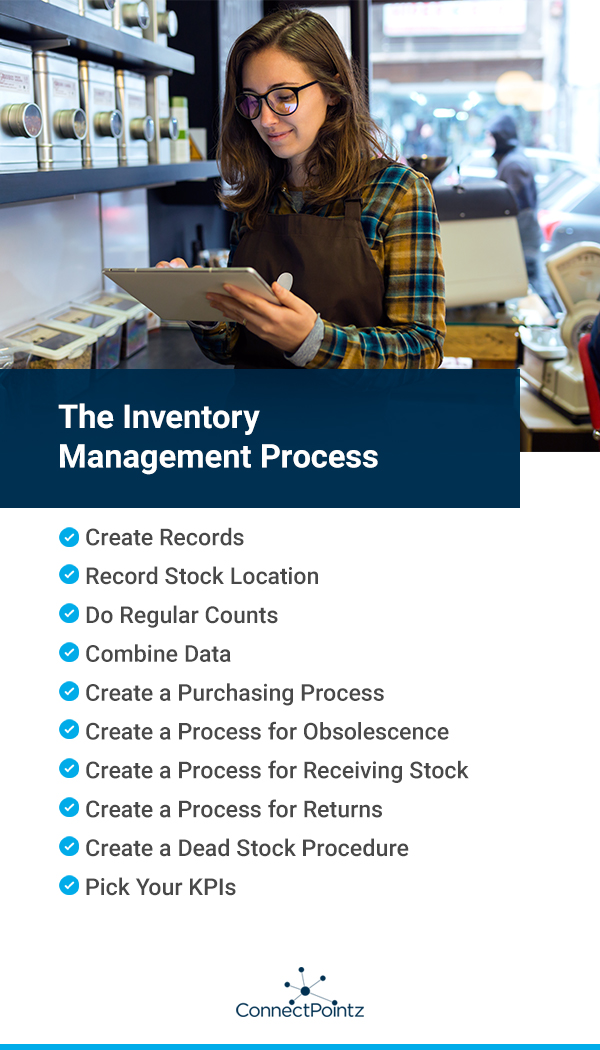
Today's business environment prioritizes multiple sales channels and high-speed order fulfillment to drive customer satisfaction. With many moving parts, maintaining updated inventory levels is essential. Whether your business deals with raw materials or finished products, constantly changing inventory requires accurate tracking and careful monitoring.
Your company needs inventory management solutions to help it keep pace with demand, improve cash flow and forecast orders. We created this guide to inventory management to assist retailers and suppliers who want to enhance their operations. The inventory management best practices outlined below show how to optimize inventory management processes so you can grow today and plan for tomorrow.

What Is Inventory Management?
Inventory management involves overseeing the level and movement of your business' stock. Yet this system is more sophisticated than labeling boxes on a shelf. Effective inventory management aims to help a company achieve a balance between the goods they need and when they need them.
Effective inventory management requires supervising incoming and outgoing stock to streamline storage and order fulfillment. Tools for managing supply levels can help you pinpoint places in the supply chain to improve. A well-organized inventory lets you pick goods effectively and get orders right the first time.
Efficient inventory management also helps businesses improve restocking practices. Having an accurate count of each item is vital for ordering the right amount of new stock and storing it efficiently. With careful management, you can make huge improvements in your business' inventory handling and storage.
What Inventory Management Does
Your business needs inventory management tools to get the best ROI for its stock. There are several reasons why inventory management is important. A robust inventory management system will help you solve the following issues:
- Keeping track of stock levels.
- Planning timely reorders proportionate to customer demand.
- Determining which items to restock and which to stop selling.
- Improving storage operations to minimize costs.
This guide will address some inventory management challenges and benefits and equip your business to create an airtight inventory management process.

The Importance of Inventory Management
Inventory management is a crucial part of running a successful business. A business needs to quickly and accurately determine how much stock is left in-store and warehouses for an accurate inventory count. By keeping stock levels updated, companies can maximize their profits and improve each step in the fulfillment process. Here are five important benefits of inventory management.
1. Improves Customer Service
One of the most valuable results of good inventory management is improved customer satisfaction. When customers arrive on an e-commerce site, they expect to see whether an item is in stock before buying. If inventory levels are inaccurate or there is insufficient supply, customers may take their business to a competitor.
In a 2021 survey of global online shoppers, 5% wanted faster replacement of out-of-stock items. Businesses can do a lot to prevent out-of-stock by tracking when to restock and ensuring products are always on the shelves.
2. Improves Cash Flow
Good inventory management improves business cash flow by recognizing how much inventory is available and when to reorder. Overstocking can occupy a company's cash when it could spend the money on other operations like marketing. Under-ordering can lead to decreased sales.
Over-ordering can also cost companies additional fees. If a company has an excess of a specific product in stock, they will have to pay more to handle and store the goods until customers purchase them. Excess costs like these can quickly add up.
3. Avoids Inventory Loss
Lost inventory includes dead stock, which is inventory customers never purchase. Dead stock does not generate a high enough ROI to justify its handling and storage costs. This situation happens when companies overstock or poorly anticipate demand.
Inventory loss occurs in a variety of other ways. If a business stores items incorrectly or loses track of expiration dates, products could also spoil. Merchandise is sometimes stolen due to improper storage and tracking. An inventory management system can reduce these losses.
4. Optimizes Fulfillment
Meeting customer demand is integral to maintaining a successful business. Enhanced inventory management can help team members fulfill orders faster, reduce inaccuracies and ship products out quickly. These processes help businesses earn more profit.
An optimized order fulfillment system will also reject orders a business cannot fulfill to avoid canceling orders. Correctly stored inventory is easier for team members to pick to fill orders correctly.
5. Improves Omnichannel or Multichannel Performance
Some businesses operate only out of a brick-and-mortar site. The addition of an online channel — or several — means companies need to integrate multiple access points into their inventory management system.
Inventory must be correct across all sales channels. Automated inventory management can improve your business' messaging across its sales channels and deliver accurate information to potential customers.
6. Enables Forecasting
You want your business to thrive and grow for years to come. Forecasting customer demand is one way to promote consistent growth. Demand forecasting involves examining historical trends in sales and revenue to create a strategy to meet demand while eliminating costs.
According to a survey conducted in 2020, 51% of retailers reported that their demand planning and forecasting solutions needed improvement. Inventory management reports can help a company predict when to reorder goods and what quantity to order to avoid overstocking and understocking.
Different Inventory Management Methods
Supervising your stock may sound labor-intensive. However, several methods for improving inventory management practices can appeal to any size company.
1. Physical Audit
Physical counts are the most accurate way to determine your company's kinds and amount of inventory in stock. A physical inventory count can provide much-needed visibility into product levels, so you know what to order and when.
A complete physical audit requires sufficient workers and may be time-consuming to complete. Smaller retailers may be better suited to regularly perform this kind of inventory count.
2. Spot Checking
Spot checking aims to detect movement in inventory levels. In a spot check, team members count a small section of inventory regularly for several weeks or a couple of months. This process aims to see which items within a section move out the fastest and catch unexplained shrinkage.
Businesses can perform spot checks on one section as part of a cycle. Counting stock in multiple areas allows a company to better understand fluctuating demand and secure high-risk inventory.
3. FIFO/LIFO
FIFO and LIFO are two methods for rotating stock through your inventory. FIFO is an acronym for first in, first out. It refers to selling the first batch of products a company purchased before the newest batch. Selling the oldest stock first is an excellent way to track an item's lifecycle and prevent obsolescence and spoilage.
LIFO stands for last in, first out. It assumes that a company is selling its most recently acquired stock before its oldest supply. The International Financial Reporting Standards banned LIFO because of its susceptibility to manipulation and less accurate inventory reporting.
4. Plan Ahead
With streamlined inventory management formulas in place, purchasing new inventory becomes simplified. Gathering data about customer purchases can help a business forecast demand, giving a better idea of when to restock to keep an adequate supply of products.
Items that sell quickly will likely need to be reordered in greater quantities. Products that sell slowly may need a boost through a promotional campaign or discount. With better inventory data, you can understand your inventory's ROI to maximize every dollar in your budget.
5. Software
Once your business has determined the best methods for monitoring inventory, it needs to implement management practices. Many kinds of inventory management software are at a retailer's disposal that track performance and keep stock rotating smoothly.
Companies engaging in omnichannel retail rely on fast software solutions to give their customers a seamless experience. In one survey, 52% of businesses use inventory management systems or tools for in-aisle restocking. Software like this can help a company significantly improve its logistics and track key performance indicators (KPIs).
Key Inventory Management KPIs
Some inventory tracking KPI formulas can help you turn raw data into actionable plans for company growth. With these inventory management basics, you can strategize your storage and handling solutions to help your business make more money.
1. Turnover
Inventory turnover assesses how well inventory sells during a given period and calculates your business' efficiency. This inventory management formula takes a period and divides the cost of goods sold by the average inventory. The total indicates a company's ability to sell and restock items in a short timeframe. A high turnover rate usually demonstrates that a business is performing profitably and minimizing carrying costs per unit.
2. Sell-Through Rate
The sell-through rate of a product is how quickly it leaves the shelves. Sell-through helps you determine if a product is generating a profitable ROI and if you are purchasing the right amounts. This rate is calculated as a percentage by dividing the number of products sold over a period of time by the number of products received, then multiplying by 100.
3. Days of Inventory Outstanding
Another essential KPI is days of inventory outstanding (DIO). The DIO measures the average time it takes for inventory to sell. Find this metric by dividing the average stock by the cost of goods sold, then multiplying that sum by the days in the period. The DIO can be a helpful tool for calculating which products sell fastest and where you need to reevaluate restocking practices.
4. Safety Stock
Businesses want to avoid canceling or rejecting orders if they can, so they determine a level of inventory called safety stock for use in situations when demand is higher than supply. Calculate safety stock by multiplying the maximum daily sales volume by the maximum lead time, which is the length of time between stock entering and leaving your inventory. Divide that number by the product of the average daily sales time and the average lead time.
5. Reorder Point
The reorder point is the specific time at which inventory levels need to be replenished so companies can avoid understocking issues. To determine the reorder point for a product, multiply its lead time, in number of days, by its average daily sales volume. Then add the product's safety stock to find the point at which a product's supply needs refilling.
6. Economic Order Quantity
Economic order quantity (EOQ) is an equation for determining the most economic amount of inventory to order while reducing costs. To calculate the EOQ, multiply the item's demand in units per year by the cost of placing an order. Multiply that product by two. Then divide by the holding cost for the unit per year. Finally, find the square root of that total. The result is your EOQ.

The Inventory Management Process
Efficient inventory management is a continual process. With careful advanced planning and the willingness to implement new inventory management tips, you can develop an agile inventory management system that adjusts with your stock. The following steps demonstrate how inventory management works and how to get started.
1. Create Records
Organize a central record for every product in your inventory. Your inventory records should include the following information for each product:
- Name
- Stock-keeping unit (SKU)
- Wholesale cost
- Minimum reorder amount
- Brand
- Reorder lead time
- Retail price
- Product category
- Lot number
- Expiration date
E-commerce inventory management may also include images and size details to make picking orders easier. Update product records when any change occurs and include as much information as possible for better data collection.
2. Record Stock Location
With inventory on display at physical storefronts, in warehouses, in transit during shipping and at distribution centers, accounting for every item can be challenging.
To prevent misplacing or miscounting stock, keep a record of its location at every point along the supply chain. Using labels like radio frequency identification (RFID) tags and bar codes can help you map your inventory down to the exact section and shelf to streamline order picking.
3. Do Regular Counts
Periodic inventory counts can check that the levels recorded in your inventory management system are correct. The frequency with which you conduct counts at your company will vary based on its size and the type of inventory management system used. Some businesses count certain sections of their stock daily to account for any changes and record volatile metrics, while others count inventory once a year.
4. Combine Data
A successful inventory management system can combine sales and inventory data to produce helpful metrics. With enterprise resource planning (ERP) software integration, you can synchronize all of your company's data in a central location that integrates seamlessly with other business technology platforms. Some platforms offer an inventory management app so you can track data from your phone.
ConnectPointz provides small business integration solutions to help companies automate and streamline tasks. Custom integration software has the power to consolidate orders in one place, optimize workflow and generate tracking information and sales reports. Our software solution case studies demonstrate how ConnectPointz can help your business optimize inventory management and sales.
5. Create a Purchasing Process
Set a regular time to review inventory data and restock. Changes in seasonal demand or swings in the market quickly shift the amount of inventory your company needs to fulfill orders. With reorder point alerts and an organized process for making inventory purchases, you can eliminate unnecessary steps and save time.
6. Create a Process for Obsolescence
When trends fade or upgrades hit the market, you could experience a significant decline in interest for a product. A process for cycling these obsolete products out of your inventory can help cut holding costs, generate profit and make room for new stock.
To encourage customers to purchase outdated products, you can create a markdown or sale to boost customer interest. Determine a system for discounting slow-moving items so sales don't stagnate.
7. Create a Process for Receiving Stock
Inventory tracking begins when a new shipment enters the store or warehouse. A receiving procedure should first check the contents of the delivery to be sure the shipment is correct. Input new products into the inventory and store them. Update all selling platforms with the new quantity or product type so customers can make a purchase. Recording the details of each shipment can cut back on outages and dead stock.
8. Create a Process for Returns
When a customer returns a product, first examine it to determine if it is damaged or defective. If it is, send it for repairs, return it to your merchants or write it off — whichever suits the situation.
If the item is sellable, return it to its assigned location within your inventory and update your stock levels. Without a return process in place, you could get stuck with the unsellable returned merchandise and paying unnecessary holding costs.
9. Create a Dead Stock Procedure
A procedure for handling dead stock will improve profitability and make room for more lucrative products. Remove dead stock from the inventory for an accurate count. If you can ship some merchandise back to your merchants for credit, do so promptly. You will need to notify suppliers about defective goods. Donate, recycle or dispose of the remainder of your dead stock.
10. Pick Your KPIs
It can be easy to get lost in the details of inventory management and fail to gauge the effectiveness of your process. Pick a few inventory KPIs that will give you the data you need to evaluate your procedures. Vital KPIs include turnover rate, sell-through rate and economic order quantity. Utilizing these and other inventory management formulas can help retailers order the right amount of products and keep costs low.
Contact ConnectPointz for Custom Omnichannel Solutions
An effective inventory management system benefits a company by maximizing profits and reducing costs. Optimizing inventory processes can increase customer satisfaction by fulfilling orders quickly and accurately. With an efficient process in place, retailers can generate revenue, improve performance and plan for their future.
ConnectPointz has the experience and tools to help optimize your business operations. Our team of inventory management consultants is dedicated to creating flexible, custom solutions to integrate with any third-party platform so you can let the software work for you. We offer end-to-end automation services and a simple onboarding process. Contact ConnectPointz today to learn how we can help your company with inventory management.










































